service CHEVROLET LOW CAB FORWARD 2019 Owner's Guide
[x] Cancel search | Manufacturer: CHEVROLET, Model Year: 2019, Model line: LOW CAB FORWARD, Model: CHEVROLET LOW CAB FORWARD 2019Pages: 382, PDF Size: 5.95 MB
Page 195 of 382

Chevrolet Low Cab Forward 5.2L Diesel Engine 4500/5500 Series (GMNA-
Localizing-U.S.-12407814) - 2019 - crc - 12/13/17
194 Driving and Operating
Selective Catalytic Reduction
(SCR) System
The Selective Catalytic Reduction
(SCR) system reduces nitrogen
oxide (NOx) emissions emitted from
a diesel engine. The SCR system
reduces NOx by adding (injecting)
Diesel Exhaust Fluid (DEF) into the
exhaust system and inducing a
reaction converting NOx into water
vapor and nitrogen.
The SCR system consists of the
DEF tank, DEF Control Unit, DEF
Supply Pump and Injector, and the
SCR Catalyst. It is important to keep
a good supply of DEF in the DEF
tank at all times. Monitor the DEF
gauge to be sure the DEF tank level
does not become too low.
If the DEF level becomes too low or
incorrect fluid is added to the DEF
tank, the warning buzzer will sound,
warning and indicator lights will
come on and engine power will be
reduced. If you see these warning
and indicator lights, add DEF as
soon as possible or have your
vehicle serviced as soon as
possible.Continuing to drive for too long after
these lights come on will result in
additional warnings, more engine
power reduction and will eventually
result in a severe vehicle speed
limitation. See
“Diesel Exhaust
Fluid (DEF) Low Level Warning” and
“Incorrect Diesel Exhaust Fluid
(DEF)/SCR System Malfunction
Warnings” later in this section.
{Warning
Do not touch the water that
comes out from the muffler. The
water is mildly acidified due to the
action of oxidation catalyst inside
the muffler. In the event that the
fluid does come into contact with
your skin, completely wash it off
with water. You and others could
be seriously injured. Do not relocate or modify the
exhaust pipe, muffler, DPF, SCR,
or DEF tank, which may affect the
exhaust gas cleaning performance.
If any relocation or modification is
necessary, consult your dealer.
The SCR system continues to
operate for approximately 3 minutes
after the engine control switch is
turned to the "LOCK" position. It is
normal to hear a buzzing type noise
from the DEF supply pump
(mounted on the left side frame rail
behind the cab) during the
shutdown process.
If it is necessary to disconnect the
batteries for any reason, be sure to
wait at least 3 minutes after turning
the engine control switch to the
"LOCK" position. This will allow the
SCR system to properly complete
its shutdown processes. See
Winter
Driving 0151.
Page 199 of 382

Chevrolet Low Cab Forward 5.2L Diesel Engine 4500/5500 Series (GMNA-
Localizing-U.S.-12407814) - 2019 - crc - 12/13/17
198 Driving and Operating
DEF Tank Level is Low/Empty (cont'd)
StageStage 1 Stage 2Stage 3Stage 4
CAUTION
This message indicates incorrect DEF or an SCR system malfunction. Immediately contact
your dealer to have your vehicle serviced *2
Remarks:
*1 –See Diesel Exhaust
Fluid (DEF).
*2 –See Incorrect Diesel Exhaust
Fluid (DEF) /SCR System
Malfunction Warnings.
*3 –The warning buzzer continues
to sound every 5 minutes.
*4 –The warning buzzer continues
to sound every 5 minutes and when
driving 8 km (5 miles) or more, the
buzzer changes its sound to
continuous beeping. DEF tank low stages are as follows:
Stage 1 :
When the remaining level
of DEF becomes excessively low
the DEF gauge will change color
from green to amber. In addition,
warning and indicator lights will
come on as shown in the table and
engine power will be reduced so the
vehicle speed will not exceed
89 km/h (55 MPH).
Stage 2 : If driving is continued
without adding DEF (approximately
320 km (200 miles)) the DEF gauge,
warning and indicator lights will begin blinking. Again, engine power
will be reduced so the vehicle speed
will not exceed 56 km/h (35 MPH).
Stage 3 :
If driving is continued until
the DEF tank is empty, the DEF
gauge will change color from amber
to red and the warning and indicator
lights will begin to blink faster.
Engine power will still be reduced so
the vehicle speed will not exceed
56 km/h (35 MPH). The vehicle
speed will be limited to
8 km/h (5 MPH) either when the
vehicle is stopped after driving
Page 200 of 382
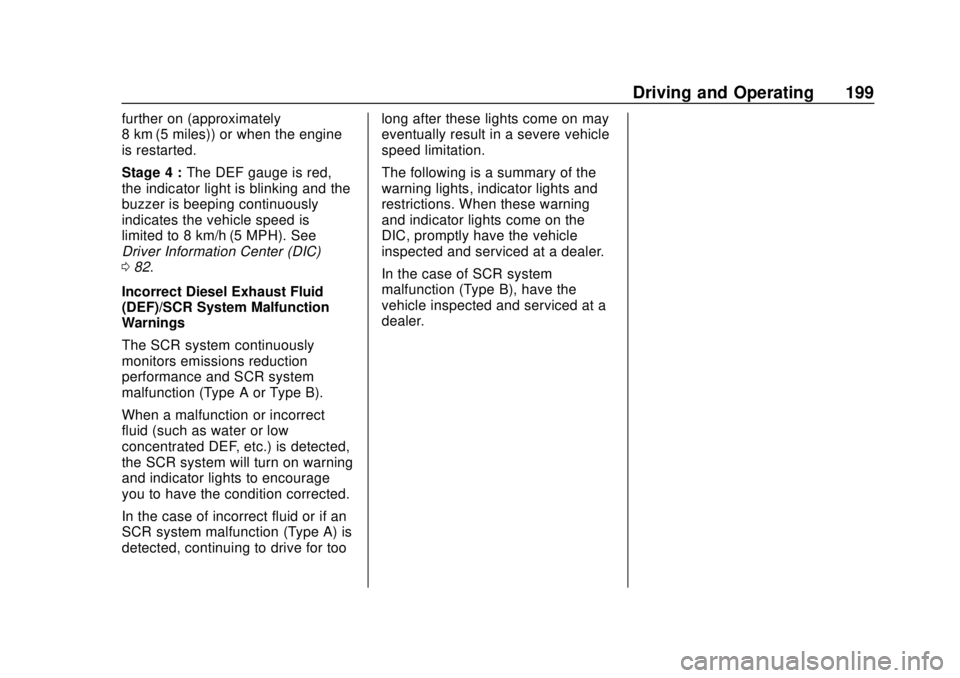
Chevrolet Low Cab Forward 5.2L Diesel Engine 4500/5500 Series (GMNA-
Localizing-U.S.-12407814) - 2019 - crc - 12/13/17
Driving and Operating 199
further on (approximately
8 km (5 miles)) or when the engine
is restarted.
Stage 4 :The DEF gauge is red,
the indicator light is blinking and the
buzzer is beeping continuously
indicates the vehicle speed is
limited to 8 km/h (5 MPH). See
Driver Information Center (DIC)
0 82.
Incorrect Diesel Exhaust Fluid
(DEF)/SCR System Malfunction
Warnings
The SCR system continuously
monitors emissions reduction
performance and SCR system
malfunction (Type A or Type B).
When a malfunction or incorrect
fluid (such as water or low
concentrated DEF, etc.) is detected,
the SCR system will turn on warning
and indicator lights to encourage
you to have the condition corrected.
In the case of incorrect fluid or if an
SCR system malfunction (Type A) is
detected, continuing to drive for too long after these lights come on may
eventually result in a severe vehicle
speed limitation.
The following is a summary of the
warning lights, indicator lights and
restrictions. When these warning
and indicator lights come on the
DIC, promptly have the vehicle
inspected and serviced at a dealer.
In the case of SCR system
malfunction (Type B), have the
vehicle inspected and serviced at a
dealer.
Page 202 of 382
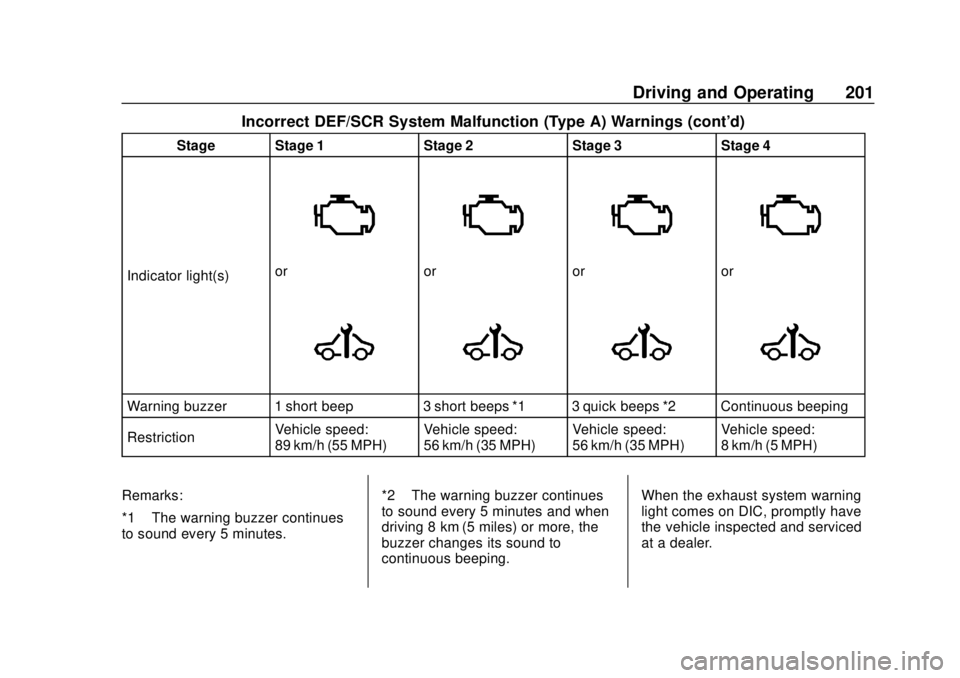
Chevrolet Low Cab Forward 5.2L Diesel Engine 4500/5500 Series (GMNA-
Localizing-U.S.-12407814) - 2019 - crc - 12/13/17
Driving and Operating 201
Incorrect DEF/SCR System Malfunction (Type A) Warnings (cont'd)
Stage Stage 1Stage 2Stage 3Stage 4
Indicator light(s)
orororor
Warning buzzer 1 short beep 3 short beeps *1 3 quick beeps *2 Continuous beeping
Restriction Vehicle speed:
89 km/h (55 MPH) Vehicle speed:
56 km/h (35 MPH)Vehicle speed:
56 km/h (35 MPH)Vehicle speed:
8 km/h (5 MPH)
Remarks:
*1 –The warning buzzer continues
to sound every 5 minutes. *2
–The warning buzzer continues
to sound every 5 minutes and when
driving 8 km (5 miles) or more, the
buzzer changes its sound to
continuous beeping. When the exhaust system warning
light comes on DIC, promptly have
the vehicle inspected and serviced
at a dealer.
Page 206 of 382
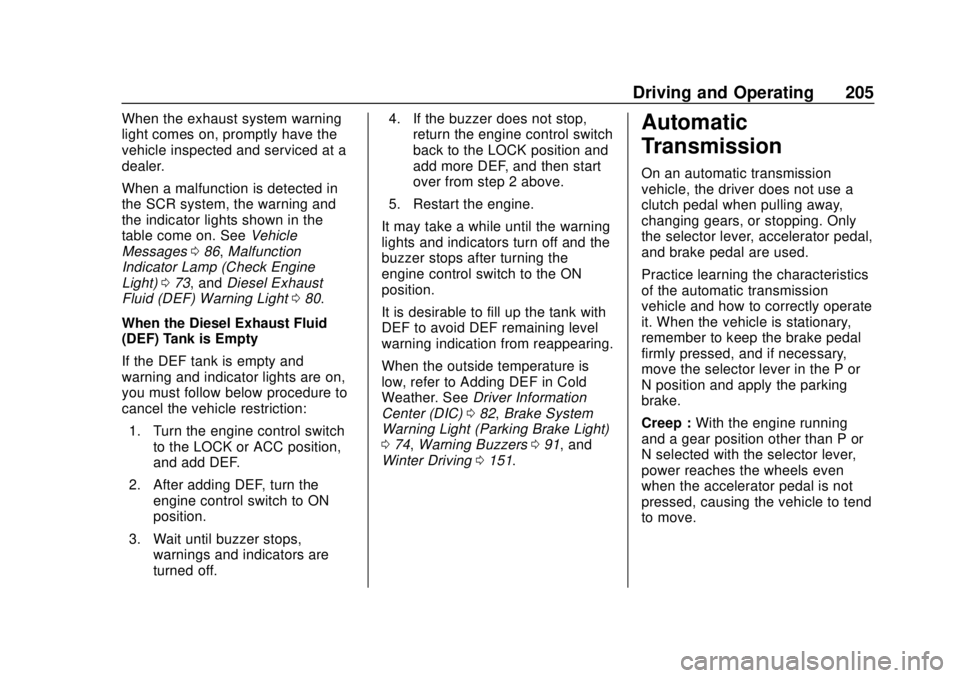
Chevrolet Low Cab Forward 5.2L Diesel Engine 4500/5500 Series (GMNA-
Localizing-U.S.-12407814) - 2019 - crc - 12/13/17
Driving and Operating 205
When the exhaust system warning
light comes on, promptly have the
vehicle inspected and serviced at a
dealer.
When a malfunction is detected in
the SCR system, the warning and
the indicator lights shown in the
table come on. SeeVehicle
Messages 086, Malfunction
Indicator Lamp (Check Engine
Light) 073, and Diesel Exhaust
Fluid (DEF) Warning Light 080.
When the Diesel Exhaust Fluid
(DEF) Tank is Empty
If the DEF tank is empty and
warning and indicator lights are on,
you must follow below procedure to
cancel the vehicle restriction: 1. Turn the engine control switch to the LOCK or ACC position,
and add DEF.
2. After adding DEF, turn the engine control switch to ON
position.
3. Wait until buzzer stops, warnings and indicators are
turned off. 4. If the buzzer does not stop,
return the engine control switch
back to the LOCK position and
add more DEF, and then start
over from step 2 above.
5. Restart the engine.
It may take a while until the warning
lights and indicators turn off and the
buzzer stops after turning the
engine control switch to the ON
position.
It is desirable to fill up the tank with
DEF to avoid DEF remaining level
warning indication from reappearing.
When the outside temperature is
low, refer to Adding DEF in Cold
Weather. See Driver Information
Center (DIC) 082, Brake System
Warning Light (Parking Brake Light)
0 74, Warning Buzzers 091, and
Winter Driving 0151.Automatic
Transmission
On an automatic transmission
vehicle, the driver does not use a
clutch pedal when pulling away,
changing gears, or stopping. Only
the selector lever, accelerator pedal,
and brake pedal are used.
Practice learning the characteristics
of the automatic transmission
vehicle and how to correctly operate
it. When the vehicle is stationary,
remember to keep the brake pedal
firmly pressed, and if necessary,
move the selector lever in the P or
N position and apply the parking
brake.
Creep : With the engine running
and a gear position other than P or
N selected with the selector lever,
power reaches the wheels even
when the accelerator pedal is not
pressed, causing the vehicle to tend
to move.
Page 220 of 382

Chevrolet Low Cab Forward 5.2L Diesel Engine 4500/5500 Series (GMNA-
Localizing-U.S.-12407814) - 2019 - crc - 12/13/17
Driving and Operating 219
Warning (Continued)
‐When tire chains are used.
‐ When driving over road
joints or bumps such as
light reflectors on the road.
‐ When driving on a bumpy
road, stone-paved road or
track.
‐ When driving over an iron
plate or manhole lid.
ABS does not work for wheel skid
during a standing start,
acceleration and cornering which
do not involve braking. On a very
slippery icy road, tires may lose
grip and steering wheel operation
may not be able to control the
vehicle's direction, resulting in
very unstable driving. Always
drive the vehicle observing a safe
speed well matched with both
road surface and tire conditions,
and avoid sudden braking. (Continued)
Warning (Continued)
If powerful engine braking is
applied on a very slippery icy
road, the drive wheels may be
locked (the ABS then does not
work), resulting in loss of vehicle
control.
When ABS is activated, a slight
vibration (especially when the
road surface is different between
right and left wheels) and pulling
may be felt on the brake pedal
and steering wheel. In addition,
an operating sound is produced
from the ABS actuators. This
does not indicate any abnormal
condition. Stay calm and operate
the steering wheel properly.
Electronic Braking force
Distribution (EBD)
EBD is a function that uses the ABS
to distribute braking force ideally
between the front and rear wheels
in order to compensate for changes
in load conditions or any shift of the load due to acceleration or
deceleration, thus preventing
premature locking of the rear
wheels.
{Warning
If a problem should occur with the
EBD function, the ABS warning
light and the brake system
warning light will come on
simultaneously.
The rear wheels will lock more
easily if there is a problem with
the EBD function. Have it
checked and serviced at the
nearest dealer as soon as
possible. You and others could be
seriously injured.
When the EBD operates, the brake
pedal may push back slightly or you
may hear a sound similar to that
generated by the ABS when
operational. Neither of them
indicates any abnormal condition.
Page 222 of 382

Chevrolet Low Cab Forward 5.2L Diesel Engine 4500/5500 Series (GMNA-
Localizing-U.S.-12407814) - 2019 - crc - 12/13/17
Driving and Operating 221
Operation of Parking Brake
The parking brake lever is located to
the right of the driver's seat.
To set the parking brake, completely
stop the vehicle. Then, without
pressing the release button (1), hold
the brake pedal down while pulling
the parking brake lever (2) all the
way up.The parking brake indicator light in
the instrument panel will come on
when the lever is pulled up. Before
you leave the driver's seat, follow
the steps under
“Parking, or Leaving
Driver's Seat”. See Braking0143.
To release the parking brake, hold
the brake pedal down while pushing
the release button of the parking
brake lever and lower the lever. The
parking brake indicator light in the
instrument panel will go out.
The parking brake indicator light is
designed to remind you if the
parking brake is not released when
the engine control switch is on.
If the parking brake warning light
remains on when the parking brake
lever is lowered, a brake failure or a
drop in air pressure may be the
cause.
Check the brake air pressure for
correct level. If the brake air
pressure is low, contact your local
Isuzu Dealer for service.
If you notice the parking brake lever
travel has increased over time, this
means the cable adjustment must be checked by a qualified
technician. Adjustment may be
required due to parking brake shoe
wear. See
Control of a Vehicle
0 139.
Inspection
Pull the parking brake lever slowly
from the fully released position while
counting the clicks produced as the
lever engages ratchet plate notches
to check that it can be raised the
proper amount and the lever is held
firmly.
Page 228 of 382
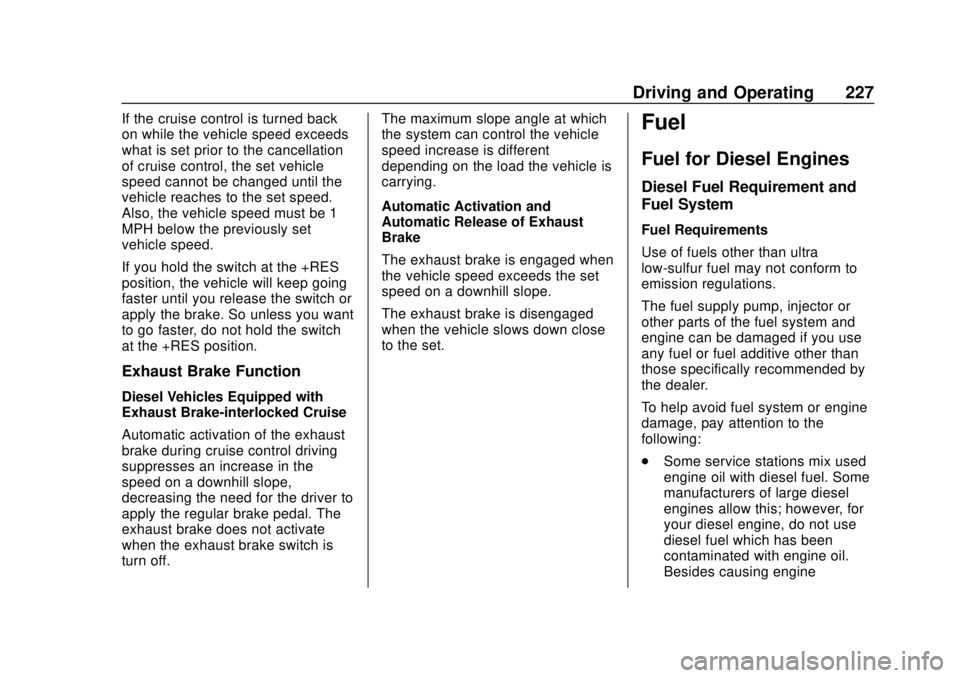
Chevrolet Low Cab Forward 5.2L Diesel Engine 4500/5500 Series (GMNA-
Localizing-U.S.-12407814) - 2019 - crc - 12/13/17
Driving and Operating 227
If the cruise control is turned back
on while the vehicle speed exceeds
what is set prior to the cancellation
of cruise control, the set vehicle
speed cannot be changed until the
vehicle reaches to the set speed.
Also, the vehicle speed must be 1
MPH below the previously set
vehicle speed.
If you hold the switch at the +RES
position, the vehicle will keep going
faster until you release the switch or
apply the brake. So unless you want
to go faster, do not hold the switch
at the +RES position.
Exhaust Brake Function
Diesel Vehicles Equipped with
Exhaust Brake-interlocked Cruise
Automatic activation of the exhaust
brake during cruise control driving
suppresses an increase in the
speed on a downhill slope,
decreasing the need for the driver to
apply the regular brake pedal. The
exhaust brake does not activate
when the exhaust brake switch is
turn off.The maximum slope angle at which
the system can control the vehicle
speed increase is different
depending on the load the vehicle is
carrying.
Automatic Activation and
Automatic Release of Exhaust
Brake
The exhaust brake is engaged when
the vehicle speed exceeds the set
speed on a downhill slope.
The exhaust brake is disengaged
when the vehicle slows down close
to the set.
Fuel
Fuel for Diesel Engines
Diesel Fuel Requirement and
Fuel System
Fuel Requirements
Use of fuels other than ultra
low-sulfur fuel may not conform to
emission regulations.
The fuel supply pump, injector or
other parts of the fuel system and
engine can be damaged if you use
any fuel or fuel additive other than
those specifically recommended by
the dealer.
To help avoid fuel system or engine
damage, pay attention to the
following:
.
Some service stations mix used
engine oil with diesel fuel. Some
manufacturers of large diesel
engines allow this; however, for
your diesel engine, do not use
diesel fuel which has been
contaminated with engine oil.
Besides causing engine
Page 229 of 382

Chevrolet Low Cab Forward 5.2L Diesel Engine 4500/5500 Series (GMNA-
Localizing-U.S.-12407814) - 2019 - crc - 12/13/17
228 Driving and Operating
damage, such fuel can also
affect emission control. Before
using any diesel fuel, check with
the service station operator to
see if the fuel has been mixed
with engine oil.
. Do not use any fuel additive
(other than as recommended
under "Biocides" in Water in
Fuel 0231). At the time this
manual was printed, no other
fuel additive was recommended.
(See your authorized dealer to
find out if this has changed.)
. Take care not to run out of diesel
fuel. If you do run out of fuel,
you may need to bleed air out of
the supply pump to re-start the
engine after fuel has been filled.
Your vehicle is designed to use
either Number 1-D or Number 2-D
diesel fuel. However, for better fuel
economy, use Number 2-D diesel
fuel whenever possible. At
temperatures below -7 °C (20 °F),
Number 2-D fuel may pose
operating problems (see "Cold
Weather Operation" which follows).
At colder temperatures, use Number 1-D fuel (if available) or use a
"winterized" Number 2-D (a blend of
Number 1-D and Number 2-D). This
blended fuel is usually called
Number 2-D also, but can be used
in colder temperatures than Number
2-D fuel which has not been
"winterized". Check with the service
station operator to be sure you get
the properly blended fuel.
Do not use fuels other than those
recommended in this manual. Doing
so may adversely affect the engine.
DIESEL FUEL/APPLICABLE
STANDARD (Sulfur content below 15ppm)
ASTM
(AMERICAN
SOCIETY FOR
TESTING and
MATERIALS) Based on D975
Number 1–D
S15 or Number
2-D S15 (below
15 ppm)Biodiesel
Biodiesel, may also be referred to
as FAME blended (Fatty-acid methyl
ester) fuel is a renewable fuel
produced from vegetable oils or
animal fats that have been
chemically modified to make it
compatible with diesel fuel.
Caution
Do not use home-made biodiesel
or home test kits because the
quality cannot be verified by
approved scientific methods. Do
not use raw vegetable oil or other
unmodified bio-oils, fats,
or blends of vegetable oil with
diesel. They could damage the
fuel system and engine, and
damages would not be covered
by the vehicle warranty.
Page 230 of 382
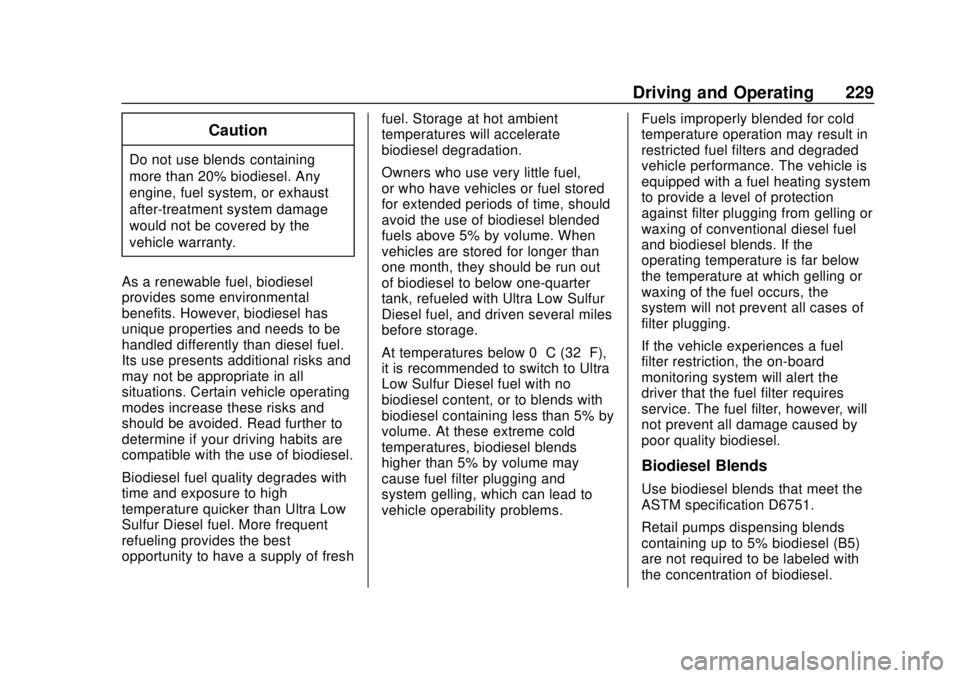
Chevrolet Low Cab Forward 5.2L Diesel Engine 4500/5500 Series (GMNA-
Localizing-U.S.-12407814) - 2019 - crc - 12/13/17
Driving and Operating 229
Caution
Do not use blends containing
more than 20% biodiesel. Any
engine, fuel system, or exhaust
after-treatment system damage
would not be covered by the
vehicle warranty.
As a renewable fuel, biodiesel
provides some environmental
benefits. However, biodiesel has
unique properties and needs to be
handled differently than diesel fuel.
Its use presents additional risks and
may not be appropriate in all
situations. Certain vehicle operating
modes increase these risks and
should be avoided. Read further to
determine if your driving habits are
compatible with the use of biodiesel.
Biodiesel fuel quality degrades with
time and exposure to high
temperature quicker than Ultra Low
Sulfur Diesel fuel. More frequent
refueling provides the best
opportunity to have a supply of fresh fuel. Storage at hot ambient
temperatures will accelerate
biodiesel degradation.
Owners who use very little fuel,
or who have vehicles or fuel stored
for extended periods of time, should
avoid the use of biodiesel blended
fuels above 5% by volume. When
vehicles are stored for longer than
one month, they should be run out
of biodiesel to below one-quarter
tank, refueled with Ultra Low Sulfur
Diesel fuel, and driven several miles
before storage.
At temperatures below 0 °C (32 °F),
it is recommended to switch to Ultra
Low Sulfur Diesel fuel with no
biodiesel content, or to blends with
biodiesel containing less than 5% by
volume. At these extreme cold
temperatures, biodiesel blends
higher than 5% by volume may
cause fuel filter plugging and
system gelling, which can lead to
vehicle operability problems.
Fuels improperly blended for cold
temperature operation may result in
restricted fuel filters and degraded
vehicle performance. The vehicle is
equipped with a fuel heating system
to provide a level of protection
against filter plugging from gelling or
waxing of conventional diesel fuel
and biodiesel blends. If the
operating temperature is far below
the temperature at which gelling or
waxing of the fuel occurs, the
system will not prevent all cases of
filter plugging.
If the vehicle experiences a fuel
filter restriction, the on-board
monitoring system will alert the
driver that the fuel filter requires
service. The fuel filter, however, will
not prevent all damage caused by
poor quality biodiesel.
Biodiesel Blends
Use biodiesel blends that meet the
ASTM specification D6751.
Retail pumps dispensing blends
containing up to 5% biodiesel (B5)
are not required to be labeled with
the concentration of biodiesel.